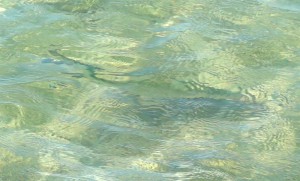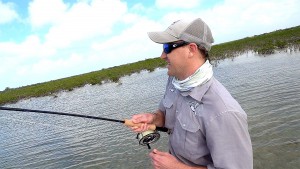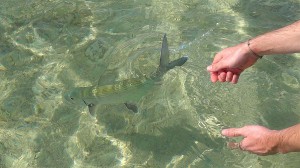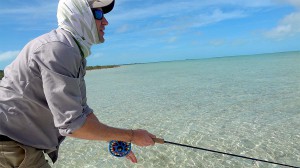By Jesse Lowry
Seeing bonefish can be a tall order for first-time flats fishermen, even those with well trained trout eyes.
First off, there can be a lot of water to cover and you don’t have the benefits you generally would on a trout stream; the likely holding places and relatively stationary fish. Bonefish move, and can move fast, and not necessarily in straight lines, which admittedly is part of the fun. A head on 60-foot shot with the wind at your back can turn into a 25-foot backhander to the back of the boat into a 20mph wind in a heartbeat; absolute tranquility to pure chaos in 4.9 seconds.
 Now this shouldn’t put you off taking the leap and booking your first trip to the flats. You don’t have to be able to see the bonefish right away to catch them. On a recent trip to Bair’s Lodge, a first timer to the flats caught 8 bonefish on the first day and commented that he didn’t see a single one until they were pretty much at the boat. This is the result of the guide spotting fish for you, calling out shots, talking you through how to strip the fly to convince the bones to eat, the Bahamian guides are pros at this.
Now this shouldn’t put you off taking the leap and booking your first trip to the flats. You don’t have to be able to see the bonefish right away to catch them. On a recent trip to Bair’s Lodge, a first timer to the flats caught 8 bonefish on the first day and commented that he didn’t see a single one until they were pretty much at the boat. This is the result of the guide spotting fish for you, calling out shots, talking you through how to strip the fly to convince the bones to eat, the Bahamian guides are pros at this.
But what if you want to start seeing fish like the guides do and get the most out of your trip? Here are a few tricks I found helped me:
The hookup:
 You’ve put your cast to where the guide called the fish and wham, bang, whiz, the fish is on and you’re into the backing. Now you’re focusing on line management and fighting the fish. You also have got the perfect opportunity to locate and watch a bonefish on the flats. Look to the end of your fly line and watch for the shadow, see if you can actually see the fish and watch how it disappears and reappears, and looks different on different bottoms, it should give you at least a taste of what to look for.
You’ve put your cast to where the guide called the fish and wham, bang, whiz, the fish is on and you’re into the backing. Now you’re focusing on line management and fighting the fish. You also have got the perfect opportunity to locate and watch a bonefish on the flats. Look to the end of your fly line and watch for the shadow, see if you can actually see the fish and watch how it disappears and reappears, and looks different on different bottoms, it should give you at least a taste of what to look for.
The release:
 You’ve landed your fish, snapped a quick picture and you’re about to release it, turn around and hop back in the boat, or sort out your line on the deck. Stop right there! Release the fish and try follow it swimming off for as long as you can see it, you may only see it for 20 feet, or you may see it and the nervous water (wake it creates while swimming) for a few hundred yards if the conditions are right.
You’ve landed your fish, snapped a quick picture and you’re about to release it, turn around and hop back in the boat, or sort out your line on the deck. Stop right there! Release the fish and try follow it swimming off for as long as you can see it, you may only see it for 20 feet, or you may see it and the nervous water (wake it creates while swimming) for a few hundred yards if the conditions are right.
The guide:
Your guide is the best source of information you’ve got. Ask questions; what is he looking for, where is he looking, how does he know it’s not a bonefish? If you think you see a fish point it out, they may have missed it. Worst case you get a little chirp “that’s a rock, bonefish move mon.” Obviously don’t point out every rock on the flat or your guide will get a little annoyed, but when you see something convincing point it out, and get some feedback from the guide.
The passenger:
 If there are two of you fishing on the skiff, you will have some down time while it’s your partner’s turn on the casting deck. You can kick back have a Kalik, change you fly, manage your partner’s line. Or you can take advantage of what I think is the most opportune time to develop your fish spotting abilities. For one, you’re not hindered with the pressure of making the shot, casting, managing the wind, the line…. well you pretty much have nothing to worry about other than helping to manage your partner’s line on the deck/bottom of the boat. So use this time to its fullest, if you are able to get a better vantage point standing on the seat, cooler, or deck do it (be sure to ask your guide and partner if they are ok with it first, stay out of the way, don’t make noise, and don’t shirk your line management duties). Once on your perch or at least settled in a spot, scan the flats, silently help point out fish if you see them, the guide will call it if he agrees with your assessment. Also when the guide calls a fish, look for it. You have more time to spot it, as you’re not worried about casting to it. Obviously you can do all of the above listed tricks while in the passenger seat as well.
If there are two of you fishing on the skiff, you will have some down time while it’s your partner’s turn on the casting deck. You can kick back have a Kalik, change you fly, manage your partner’s line. Or you can take advantage of what I think is the most opportune time to develop your fish spotting abilities. For one, you’re not hindered with the pressure of making the shot, casting, managing the wind, the line…. well you pretty much have nothing to worry about other than helping to manage your partner’s line on the deck/bottom of the boat. So use this time to its fullest, if you are able to get a better vantage point standing on the seat, cooler, or deck do it (be sure to ask your guide and partner if they are ok with it first, stay out of the way, don’t make noise, and don’t shirk your line management duties). Once on your perch or at least settled in a spot, scan the flats, silently help point out fish if you see them, the guide will call it if he agrees with your assessment. Also when the guide calls a fish, look for it. You have more time to spot it, as you’re not worried about casting to it. Obviously you can do all of the above listed tricks while in the passenger seat as well.
As with all things fly fishing, nothing makes up for time on the water.
Hopefully this helps you get the most out of the time you do spend on the water. And who knows, you might start spotting fish the guide missed and start hooking up on your own.
Jesse Lowry Gink & Gasoline www.ginkandgasoline.com hookups@ginkandgasoline.com Sign Up For Our Weekly Newsletter!
Sign Up For Our Weekly Newsletter!

